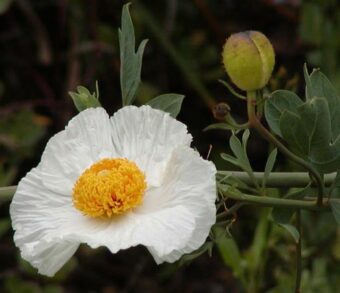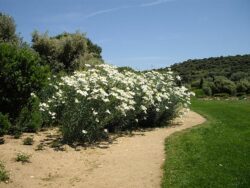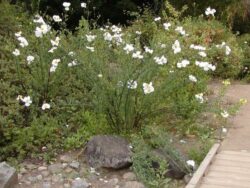In this article, we will discover how to grow the heavenly-scented Romneya in containers. Romneya is a genus of two species of flowering subshrub that belong to the Papaveraceae (the Poppy) family. The genus is named after the Irish astronomer, John Thomas Romney Robinson and has the common name of Matilija poppies or Tree poppies. Romneyas are native to California and North America, which gives the idea that the plant is not totally hardy.

The two species you will find are Romneya coulteri and Romneya trichocalyx. The bluish-green leaves are deeply cut with a small fringe of hairs at the margins. In summer, up to 13cm wide, white, fragrant flowers appear that have an intensive yellow centre. The yellow centre is a prominent boss of golden stamens. Each flower is borne individually on the tips of the upright stems.
It is a plant that is not only tidy but is slow to establish, but once it has established it has the tendency to spread quickly and can become invasive. This is not much of a problem if you grow them in containers. The reason for slow establishment is that the plant hates to be transplanted. This could result in the death of the plant if it does not establish at all.
Find out how to grow Romneya in containers in this article.
GROWING ROMNEYA IN CONTAINERS
First, you will need to choose a large enough container that can take the quick-growing roots once established. A half barrel is ideal but whatever you choose make sure it has plenty of drainage holes at the bottom. To this container add a 5cm layer of gravel to help with drainage even further. On top o of this create a free-draining but light-growing media by mixing 70% by volume of multipurpose compost with 30% by volume of Perlite. Fill the container to within 5cm of the top rim with this mixture.
Dig a hole at the centre of the container slightly bigger than the root ball it came in the pot that you purchase it from. Drop the plant in so that the top of the root ball is at the same level as the top surface of the compost in the container. Backfill with the growing media so that it is snug as a bug in a rug and no gaps remain, using more compost if you find it is necessary. Firm the plant in and water well.
On top of the compost, you can add a deep layer of mulch of bark chippings.
THE BEST GROWING CONDITIONS
First, they do not like to be placed in frost pockets, so place them in a south-facing spot near a wall, where they will get as much sun as possible.

You will need to water well until it is well established, which could be a while, After this, you can water when 5cm below the top surface of the compost feels dry to the touch, When you do water make sure you do until it emerges from the drainage holes.
In early spring give an annual dressing of slow-release, general–purpose fertilizer to give a boost during the growing season.
Pruning is relatively simple as all you need to do is cut back all stems to 5cm above the ground in March. The tender stems would have been killed in cold, harsh frosty winters. Do not worry as new stems will soon emerge once the weather gets warm in spring.
Propagation is either via basal cuttings taken in spring and planted in pots full of multipurpose compost in a cold frame or by root cuttings taken in winter.
PESTS AND DISEASES
For some reason, caterpillars seem to love the leaves. It is best to remove them by hand if seen or if there are too many, you can spray with a systemic insecticide that works with caterpillars in general.
In terms of diseases, powdery mildew can be a major problem. This is avoided by preventing the plant from getting dry at the roots, by having gaps between the stems, and by having good ventilation.
VARIETIES TO GROW

The two species that you can find, as mentioned in the introduction, are
Romneya coulteri is a thicket-forming shrub that grows up to 1.5m high. It is grown for its deeply cut, blue-green leaves and large, white and yellow-centred flowers that appear in summer. A noted variety is ‘White Cloud’ as the flowers are some of the largest of all Romneya species.
An alternative is Romneya trichocalyx, which is similar to R. coulteri. The only difference is that the sepals are hairy and the flowers and fruits are smaller.
CONCLUSIONS
In this article, we have discussed how to grow the wonderfully colourful and large flowering shrub of Romneya in containers. They are easy to grow, easy to care for and tend to be pests and diseases free. They may be hard to establish tender and hate too much water, but they are a plant well worth the time and effort.
If you have any questions or comments that you wish to make on growing Romneya in containers, please do so in the comment box below,
Happy Romneya growing.
